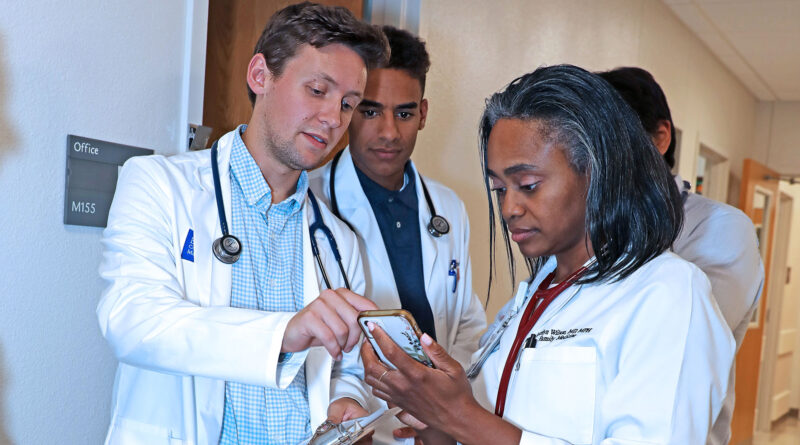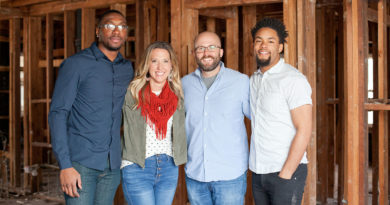New ‘white coat’ students start training in Central Texas
Baylor Scott & White begins partnership with Baylor College of Medicine
By RACHEL STRICKLAND Strickland | Photos by BRANDY CRUZ
In late 2020, Baylor Scott & White Health announced an academic collaboration with Baylor College of Medicine that resulted in the creation of a new four-year medical school in Temple, and its inaugural class began training this summer.

“This is a great opportunity to expand Baylor College of Medicine’s outstanding medical education programs to a regional medical school campus,” Dr. Paul Klotman, president, CEO and executive dean of Baylor College of Medicine, said in a statement.
The new regional medical school campus in Temple is an additional location for Baylor College of Medicine, which has another campus in Houston. The collaboration between Baylor Scott & White Health and Baylor College of Medicine is particularly exciting because it fills the needs in the area for a four-year medical school.
“It is the combined effort of two wonderful institutions,” said Dr. Alejandro Arroliga, regional dean of the new campus. “But this medical school only exists because the community needs us.”
Arroliga, a pulmonary and critical care physician who also serves as the chief clinical innovation officer and the chief academic officer for Baylor Scott & White, explained that the interview process to be accepted into the program has a holistic approach because technical knowledge is not the only deciding factor — students who also have excellent communication skills are sought after by the faculty at Baylor College of Medicine. This year’s class includes more than 220 students, and 40 of them are now training at the Temple campus.
Isabella Hardej, a member of the inaugural class of 2027, chose to apply for the program after graduating with her bachelor’s degree from the University of Texas at Austin.
“Central Texas has a special place in my heart,” she said. “I wanted to serve the communities here and get my medical education here.”
Hardej applied to medical schools all over the country but chose to accept the offer to attend Baylor College of Medicine because it’s one of the best medical schools in the country, and the Temple campus offers small class sizes and access to Baylor Scott & White Health.
“(The hospital) pulls from a lot of rural communities that don’t necessarily have the best access to care,” she said. “So, the hospital sees pretty much every condition and every type of patient that you could imagine. It really does make a very robust setting for a clinical education.”

Hardej is also excited to be part of Temple’s inaugural class because of the opportunity to set the standards high for future students.
“There are all these wonderful traditions that Baylor College of Medicine already has that we will take part in,” she added. “But there’s also an opportunity for us, as the first class, to create the culture of the school from the ground up.”
After the first few weeks of class, the students participated in the traditional white coat ceremony at the Frank W. Mayborn Civic & Convention Center, which honored the class of 2027. This symbolic event represents the students’ entry into medical school, and their family and friends are invited to be there to support them reaching such a big milestone. During his ceremonial speech, Arroliga explained the meaning behind the white coats, which comes from the 19th century when physicians began to wear white garments to symbolize compassion, honesty, and the fact that they are the healers of their community.
“Look around,” Arroliga told Baylor’s newest medical students, who embody a wide range of backgrounds and ethnicities. “You represent what the state of Texas looks like now and the way the state of Texas will look in the future. To have a diverse group of medical students is good medicine. It translates into better outcomes to our community.”

The 40 students at the Temple campus are currently taking foundational science courses, but Hardej said that in January 2025, they will begin clinical rotations at Baylor Scott & White hospital and clinics, McLane Children’s hospital, as well as the Central Texas Veterans Health Care System. At that point, they will be able to see patients and help come up with a health plan, while still under the supervision of residents and attending physicians.
“We’ll really get to start putting those skills into practice,” she added.
The instruction takes place in the medical education building, just across the parking lot from Baylor Scott & White Health, but they also have classes in the medical education center, which is connected to the hospital by a hallway. The professors and faculty members are from the Temple and Houston campuses, both of which share the same curriculum, classes and exams. The in-person classes are alternately live-streamed from each campus, and the students who are watching virtually can still interact and ask questions.
According to Hardej, the concept of the medical school in Temple was something that Baylor Scott & White Health, Baylor College of Medicine and the community wanted — local medical students who understand the needs of the area and how to best serve their patients.
“They were looking for a four-year arrangement, and Baylor College of Medicine had the same vision for bringing more physicians into the Central Texas region,” she said.
“We are very thankful, not only to Baylor College of Medicine, but to Baylor Scott & White, and to the Bell County community, for their support over the years” Arroliga said. “And we are proud that we will be able to deliver outstanding physicians to Texas.”




